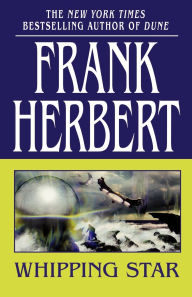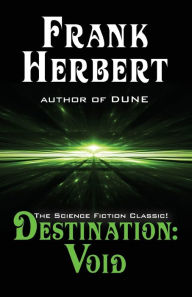Dune at 50: Crossover or Cross-Series Contamination?
 Science fiction fans love to speculate. When presented with a fully realized world stocked with alien creatures and futuristic concepts, the first thing we do is pick it apart to see how it ticks. Maybe there are hidden references to uncover, minor inconsistencies that need pointing out, or better still, a universe-shattering conspiracy to unveil!
Science fiction fans love to speculate. When presented with a fully realized world stocked with alien creatures and futuristic concepts, the first thing we do is pick it apart to see how it ticks. Maybe there are hidden references to uncover, minor inconsistencies that need pointing out, or better still, a universe-shattering conspiracy to unveil!
Frank Herbert was a meticulous writer who managed to craft six books in the same universe that stay persistently, internally logical. Here’s the catch, though: Frank wrote more than just the Dune series, and a few of his other books brush lightly against the Dune-iverse. Inquiring sci-fi minds want to know… Did Herbert intentionally hide these clues in his other works, or are the crossovers just bonuses for loyal readers?
Whipping Star
Whipping Star
In Stock Online
Paperback $16.99
Whipping Star meets Dune
Honored Matres, the twisted, post-Scattering versions of the Bene Gesserit, loved superfluous symbols of rank and power. Chairdogs were one of their many toys, and they made several quick appearances in Heretics of Dune and Chapterhouse: Dune. Picture a nice, comfy chair with a built-in massager. Now imagine that chair isn’t made of cushions and electronic parts, but flesh and blood. That’s a chairdog: a semi-sentient piece of furniture created through genetic manipulation. Grotesque, yes, and just the sort of thing an Honored Matre would love.
Rewind a decade and a half from the 1984 release of Heretics, and we get Frank Herbert’s Whipping Star, a science fiction novel set in the far future in which humans have made contact with numerous alien species. As it turns out, chairdogs made their debut here, and their origin is explained in greater detail than in the Dune novel. Could the events in Whipping Star be a hint as to what happened during the mysterious Scattering? Or did Herbert just like the idea and copy it?
Whipping Star meets Dune
Honored Matres, the twisted, post-Scattering versions of the Bene Gesserit, loved superfluous symbols of rank and power. Chairdogs were one of their many toys, and they made several quick appearances in Heretics of Dune and Chapterhouse: Dune. Picture a nice, comfy chair with a built-in massager. Now imagine that chair isn’t made of cushions and electronic parts, but flesh and blood. That’s a chairdog: a semi-sentient piece of furniture created through genetic manipulation. Grotesque, yes, and just the sort of thing an Honored Matre would love.
Rewind a decade and a half from the 1984 release of Heretics, and we get Frank Herbert’s Whipping Star, a science fiction novel set in the far future in which humans have made contact with numerous alien species. As it turns out, chairdogs made their debut here, and their origin is explained in greater detail than in the Dune novel. Could the events in Whipping Star be a hint as to what happened during the mysterious Scattering? Or did Herbert just like the idea and copy it?
Destination: Void
Destination: Void
Paperback $14.99
Destination: Void meets Dune
Although they didn’t make an appearance in the first book, gholas became one Dune’s mainstay metaphors for what it means to be human. They are clones created by the Bene Tleilax by taking host cells, dropping them in an axolotl tank, and growing them like a house plant. The entire process remains shrouded in mystery, so much so that we never really find out what an axolotl tank is. Some sort of bubbling vat brimming with tubes and purple goo? Or, as one character suggests, made of remnants of Tleilaxu females: a monstrous, multipurpose biological incubator?
The connection between Dune and Destination: Void hinges on these axolotl tanks. They’re mentioned, briefly, in Destination: Void as well as its sequel, The Jesus Incident, both stories about the perils of artificial intelligence (just like Dune!). Axolotl tanks weren’t introduced until Dune: Messiah was published in 1969, so they technically made their debut in Destination: Void before becoming a mainstay for the Bene Tleilax in Dune.
Here’s the million solaris question: are axolotl tanks a concrete connection between two series whose underpinnings involve the development and catastrophic failure of artificial intelligence? Are Destination: Void and the following Pandora Sequence essentially stories from the Butlerian Jihad era of Dune? The likelihood of a true crossover is pretty low, but still, given the thematic similarities, it’s hard not to dream up a conspiracy or two.
We’re celebrating the 50th anniversary of Dune throughout 2015. View the complete article series here.
Destination: Void meets Dune
Although they didn’t make an appearance in the first book, gholas became one Dune’s mainstay metaphors for what it means to be human. They are clones created by the Bene Tleilax by taking host cells, dropping them in an axolotl tank, and growing them like a house plant. The entire process remains shrouded in mystery, so much so that we never really find out what an axolotl tank is. Some sort of bubbling vat brimming with tubes and purple goo? Or, as one character suggests, made of remnants of Tleilaxu females: a monstrous, multipurpose biological incubator?
The connection between Dune and Destination: Void hinges on these axolotl tanks. They’re mentioned, briefly, in Destination: Void as well as its sequel, The Jesus Incident, both stories about the perils of artificial intelligence (just like Dune!). Axolotl tanks weren’t introduced until Dune: Messiah was published in 1969, so they technically made their debut in Destination: Void before becoming a mainstay for the Bene Tleilax in Dune.
Here’s the million solaris question: are axolotl tanks a concrete connection between two series whose underpinnings involve the development and catastrophic failure of artificial intelligence? Are Destination: Void and the following Pandora Sequence essentially stories from the Butlerian Jihad era of Dune? The likelihood of a true crossover is pretty low, but still, given the thematic similarities, it’s hard not to dream up a conspiracy or two.
We’re celebrating the 50th anniversary of Dune throughout 2015. View the complete article series here.

